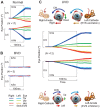Electrical vestibular stimulation after vestibular deafferentation and in vestibular schwannoma
- PMID: 24349188
- PMCID: PMC3861342
- DOI: 10.1371/journal.pone.0082078
Electrical vestibular stimulation after vestibular deafferentation and in vestibular schwannoma
Abstract
Background: Vestibular reflexes, evoked by human electrical (galvanic) vestibular stimulation (EVS), are utilized to assess vestibular function and investigate its pathways. Our study aimed to investigate the electrically-evoked vestibulo-ocular reflex (eVOR) output after bilateral and unilateral vestibular deafferentations to determine the characteristics for interpreting unilateral lesions such as vestibular schwannomas.
Methods: EVOR was recorded with dual-search coils as binocular three-dimensional eye movements evoked by bipolar 100 ms-step at EVS intensities of [0.9, 2.5, 5.0, 7.5, 10.0] mA and unipolar 100 ms-step at 5 mA EVS intensity. Five bilateral vestibular deafferented (BVD), 12 unilateral vestibular deafferented (UVD), four unilateral vestibular schwannoma (UVS) patients and 17 healthy subjects were tested with bipolar EVS, and five UVDs with unipolar EVS.
Results: After BVD, bipolar EVS elicited no eVOR. After UVD, bipolar EVS of one functioning ear elicited bidirectional, excitatory eVOR to cathodal EVS with 9 ms latency and inhibitory eVOR to anodal EVS, opposite in direction, at half the amplitude with 12 ms latency, exhibiting an excitatory-inhibitory asymmetry. The eVOR patterns from UVS were consistent with responses from UVD confirming the vestibular loss on the lesion side. Unexpectedly, unipolar EVS of the UVD ear, instead of absent response, evoked one-third the bipolar eVOR while unipolar EVS of the functioning ear evoked half the bipolar response.
Conclusions: The bidirectional eVOR evoked by bipolar EVS from UVD with an excitatory-inhibitory asymmetry and the 3 ms latency difference between normal and lesion side may be useful for detecting vestibular lesions such as UVS. We suggest that current spread could account for the small eVOR to 5 mA unipolar EVS of the UVD ear.
Conflict of interest statement
Figures





References
-
- Purkinje JE. (1823) Commentatio de examine physiologico organi visus et systematis cutanei. Vratislavae, Typis Universitatis.
-
- Politzer A (1909) In: Ballin MJ, Heller CL, editors. Diseases of the ear, fifth edition, Bailliere, Tindall and Cox, London. pp. 90–92.
-
- Goldberg JM, Smith CE, Fernandez C (1984) Relation between discharge regularity and responses to externally applied galvanic currents in vestibular nerve afferents of the squirrel monkey. J Neurophysiol 51: 1236–1256. - PubMed
-
- Aw ST, Todd MJ, Curthoys IS, Aw GE, McGarvie LA, et al... (2010) Vestibulo-ocular responses to sound, vibration and galvanic stimulation. In: Eggers SDZ, Zee DS, editors. Vertigo and Imbalance: Clinical Neurophysiology of the Vestibular System. Handbook of Clinical Neurophysiology. Elsevier Vol 9. pp. 165–180.
-
- Vailleau B, Qu'hen C, Vidal PP, de Waele C (2011) Probing residual vestibular function with galvanic stimulation in vestibular loss patients. Otol Neurotol 32: 863–71. - PubMed
Publication types
MeSH terms
LinkOut - more resources
Full Text Sources
Other Literature Sources
Medical

